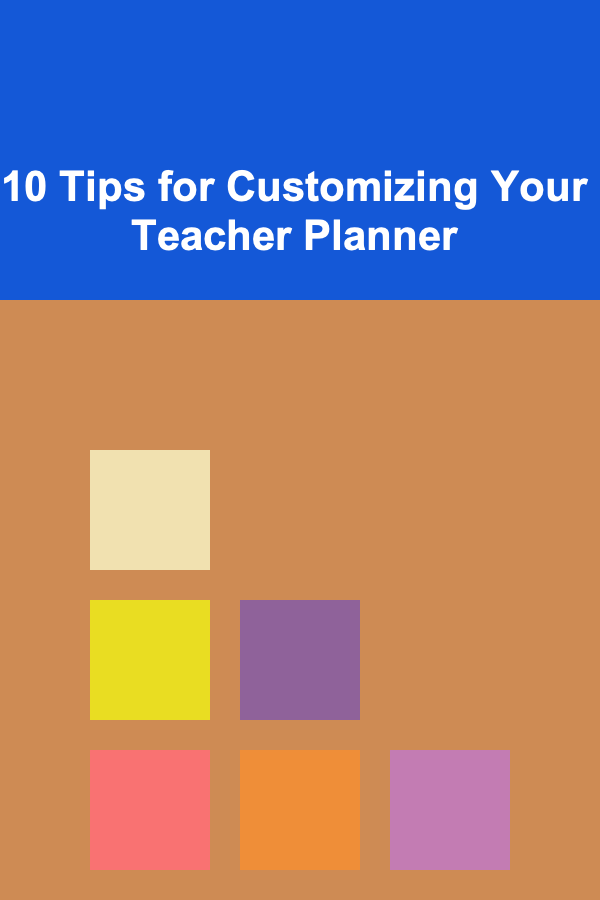
10 Tips for Customizing Your Teacher Planner
ebook include PDF & Audio bundle (Micro Guide)
$12.99$7.99
Limited Time Offer! Order within the next:

As a teacher, staying organized is crucial for creating an effective and smooth classroom environment. One of the best ways to keep track of everything---from lesson plans to student progress---is by using a teacher planner. A well-structured planner can help you stay on top of your responsibilities, prioritize tasks, and create a more organized, productive classroom.
But what if your teacher planner doesn't quite fit your needs? What if it feels too generic, or doesn't align with your teaching style and workflow? The good news is that customizing your teacher planner can be an incredibly rewarding and transformative experience. In this article, we'll explore 10 tips for personalizing your planner so it works exactly the way you need it to.
Choose the Right Planner Format
Before diving into customization, it's important to select a planner format that suits your teaching style and needs. Planners come in various formats, including daily, weekly, and monthly layouts, as well as digital and paper versions.
- Daily Planners: If you like to plan each day meticulously and track every small task, a daily planner might be ideal. This format provides ample space for detailed schedules, to-do lists, and notes.
- Weekly Planners: For a more big-picture view, a weekly planner provides space to outline lessons and tasks for the entire week. This is useful for teachers who prefer to see a broad overview of their schedule.
- Monthly Planners: These planners are perfect for long-term goals and tracking important dates like exams, holidays, and parent-teacher conferences.
- Digital Planners: Digital planners (on apps like Google Calendar, Notion, or GoodNotes) offer flexibility and allow for easy editing and collaboration with colleagues.
Once you've chosen the format that fits your needs, it's time to personalize it to match your teaching style.
Add Personal Sections
While most planners come with basic sections, adding a few personal sections can make your planner feel more tailored to you. Here are some ideas for sections you can add:
- Goals and Reflections: Include a section at the beginning of each week or month to jot down teaching goals and reflect on your progress. This could help you stay focused and track your professional growth.
- Student Roster: A page dedicated to a list of students with their names, contact information, and important notes about their learning preferences or challenges. This allows you to easily reference student data when planning.
- Important Dates: While most planners include major holidays, you might want a dedicated section to highlight key school events, deadlines, or activities.
- Health and Well-being: Teaching can be demanding, so why not add a section to track your well-being? Include a section for exercise, self-care, or mental health check-ins to ensure you're staying balanced.
Incorporate Lesson Planning Templates
Lesson planning is a fundamental part of teaching, and it's essential to have a system that works for you. While many planners include a basic section for lesson planning, you can make it more effective by customizing it with the following templates:
- Lesson Outline: Create a section with slots for the lesson's objectives, materials needed, key concepts, activities, and assessments. This format will help ensure your lessons are organized and comprehensive.
- Differentiation: Add a column or space where you can write down accommodations or modifications for students who need additional support. This ensures that you're meeting the needs of all learners.
- Reflection on Lessons: After each lesson, make a quick note about what went well and what could be improved. This section is a great way to track your progress and refine your teaching methods over time.
By incorporating these templates, your planner will become a valuable tool for lesson preparation and reflection.
Use Color Coding
Color coding can help you quickly navigate your planner and visually organize different aspects of your teaching life. Different colors can represent different subjects, types of tasks, or levels of urgency. Here's how you can use color effectively:
- Subject Codes: Assign a specific color for each subject or class you teach (e.g., blue for math, green for science, red for English). This will help you quickly spot where you need to focus.
- Task Prioritization: Use different colors to mark tasks by priority. For example, use green for low-priority tasks, yellow for medium, and red for high-priority tasks.
- Student Groups: If you teach different groups of students, color coding their names or tasks based on the group they belong to can make it easier to manage.
Using color coding helps break up the monotony of the planner and allows for a more visually engaging experience, which will make your planning more efficient.
Include a To-Do List
A to-do list is one of the most practical additions you can make to your teacher planner. Even if your planner already includes weekly or daily layouts, a dedicated to-do list will give you an easy way to track tasks, reminders, and projects that need to be done.
- Daily Tasks: Include a "To-Do" section at the top of each page or on the sidebar for everyday tasks. This could include grading, parent emails, meetings, and anything else that requires your attention.
- Long-Term Projects: Add a section for longer-term tasks, such as preparing for parent-teacher conferences, grading large assignments, or creating new lesson plans for upcoming units.
Breaking down big tasks into smaller steps will help you stay on top of everything and ensure nothing gets overlooked.
Add Customizable Student Trackers
Tracking student progress is a key part of teaching, and a customized tracker can make it easier to monitor your students' achievements and areas of growth.
- Grades and Feedback: Create a tracker where you can record grades for assignments, tests, and projects. Additionally, include space to write personalized feedback for each student.
- Behavior Tracker: Keep track of individual student behavior with a quick reference chart. This can help you stay proactive in addressing any behavioral concerns.
- Attendance: If your planner doesn't already have an attendance section, consider adding one to monitor student attendance easily.
Including these trackers will allow you to monitor your students' academic progress and well-being, making it easier to adjust your teaching strategies accordingly.
Incorporate Time Blocking
Time blocking is a method that involves breaking your day into specific chunks of time dedicated to different tasks. For teachers, time blocking can help you maintain focus and ensure that everything from grading to lesson planning is completed in a structured manner.
- Block Out Class Time: Allocate time blocks for each class, giving you a visual representation of your teaching schedule.
- Set Aside Planning Time: Reserve time for lesson planning, grading, and other essential tasks. Don't forget to add personal time blocks as well for breaks or self-care!
Time blocking can help you stay on track and ensure that your day flows smoothly without feeling overwhelmed by conflicting tasks.
Personalize the Cover and Design
Sometimes, the simplest way to make your teacher planner truly your own is by customizing its appearance. The cover and design of your planner set the tone for your organization, so make it something that inspires and motivates you. You could:
- Add a Personal Touch: If you enjoy arts and crafts, consider decorating your planner's cover with stickers, inspirational quotes, or a picture of your class. You could even personalize the planner with your name or a logo.
- Select a Fun Theme: Whether it's based on your favorite colors, patterns, or subject, a custom theme will make your planner more visually appealing and energizing to use.
A personalized planner cover is a small change that can make a big difference in how you approach your planning and teaching.
Add Space for Collaboration and Communication
Teaching is often a collaborative effort, whether it's with your fellow teachers, parents, or other staff members. Incorporating sections for communication and collaboration can streamline these important relationships.
- Parent Contact Log: Create a dedicated section where you can keep track of meetings, phone calls, and email communications with parents.
- Staff Collaboration Notes: Add space to jot down notes from meetings with colleagues or school staff.
This will make it easier to stay on top of important communications and ensure that all necessary follow-up is done.
Review and Adjust Regularly
One of the best ways to keep your planner effective is by regularly reviewing and adjusting it as necessary. You'll find that as the year progresses, your teaching style, classroom environment, and responsibilities may evolve. By revisiting your planner periodically, you can ensure that it remains aligned with your current needs.
- Weekly Check-ins: Take a moment at the end of each week to review your planner. Are there any sections that are no longer useful? Is there a new section you want to add? Make adjustments as needed.
- End-of-Year Review: At the end of the school year, reflect on how well your planner worked for you and what could be improved. This will help you design a more effective planner for the upcoming year.
Conclusion
Customizing your teacher planner is not just about making it look good---it's about designing a tool that enhances your productivity, helps you stay organized, and meets the specific demands of your teaching style. By incorporating some or all of the tips mentioned above, you'll create a planner that works for you and empowers you to thrive in your teaching career. Whether you prefer a digital planner or a traditional paper version, the process of customization will make your planner a valuable resource throughout the school year.
Reading More From Our Other Websites
- [Personal Care Tips 101] How to Build a Strength Training Routine at Home
- [Organization Tip 101] How to Create a Pantry Inventory Checklist for Grocery Shopping
- [Home Pet Care 101] How to Organize Pet-Friendly Car Essentials for Daily Commutes and Emergency Situations
- [Beachcombing Tip 101] Essential Beachcombing Gear: Must-Haves for Every Shoreline Explorer
- [Personal Finance Management 101] How to Effectively Manage a Mortgage and Reduce Debt
- [Home Cleaning 101] How to Clean Your Home Naturally Without Harsh Chemicals
- [Weaving Tip 101] Stitching Tranquility: The Science Behind Weaving as a Mental Wellness Tool
- [Organization Tip 101] How to Use Time-Tracking Apps to Improve Productivity
- [Personal Investment 101] How to Use Tax-Loss Harvesting to Lower Your Investment Tax Burden
- [Scrapbooking Tip 101] Budget-Friendly Scrapbooking: DIY Materials and Upcycling Ideas

How to Craft a Resume That Gets Noticed
Read More
How to Encourage Repeat Customers at Your Yard Sale
Read More
How To Share Your Culture with Others Respectfully
Read More
How to Save Money on Tourist Traps
Read More
The Step-by-Step Guide to Critical Thinking
Read MoreHow to Create an Asset Allocation Tracker for Specific Financial Goals
Read MoreOther Products

How to Craft a Resume That Gets Noticed
Read More
How to Encourage Repeat Customers at Your Yard Sale
Read More
How To Share Your Culture with Others Respectfully
Read More
How to Save Money on Tourist Traps
Read More